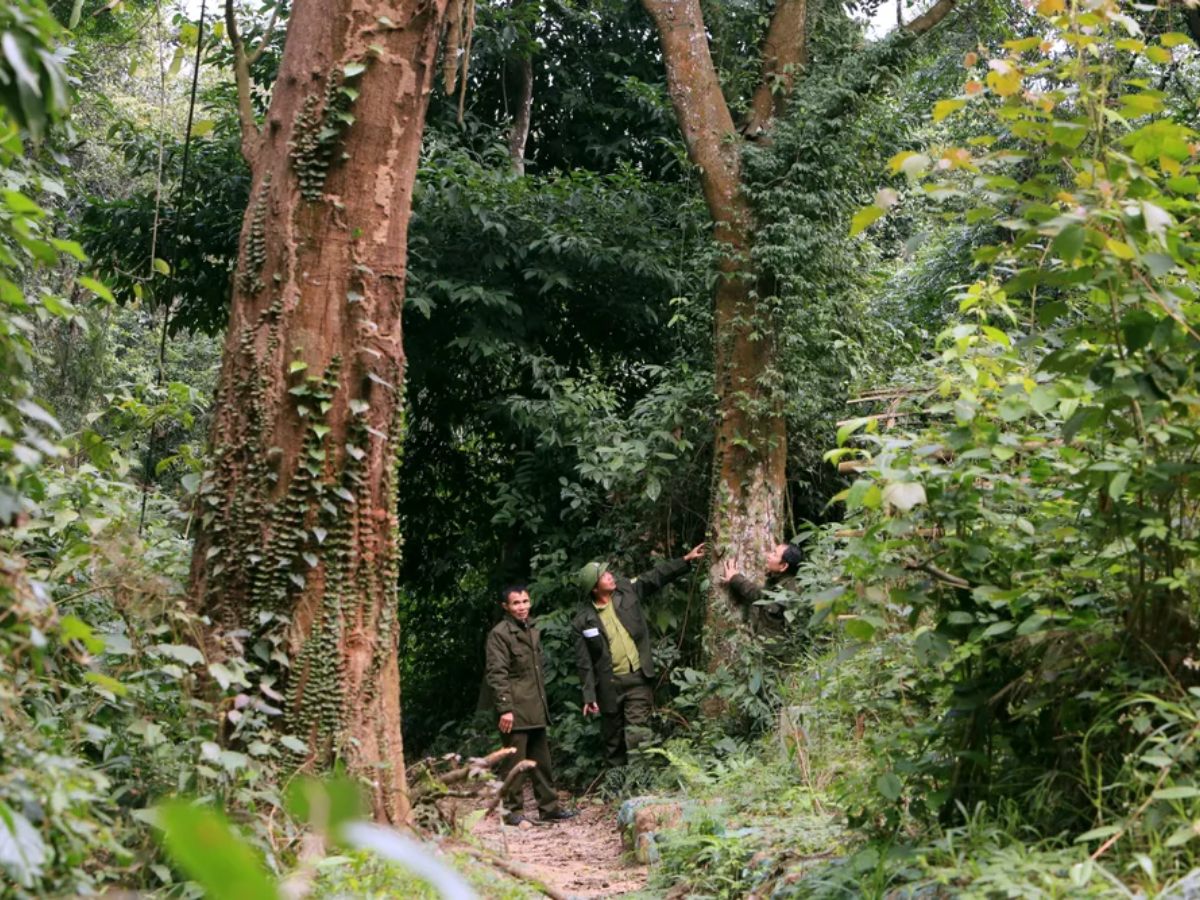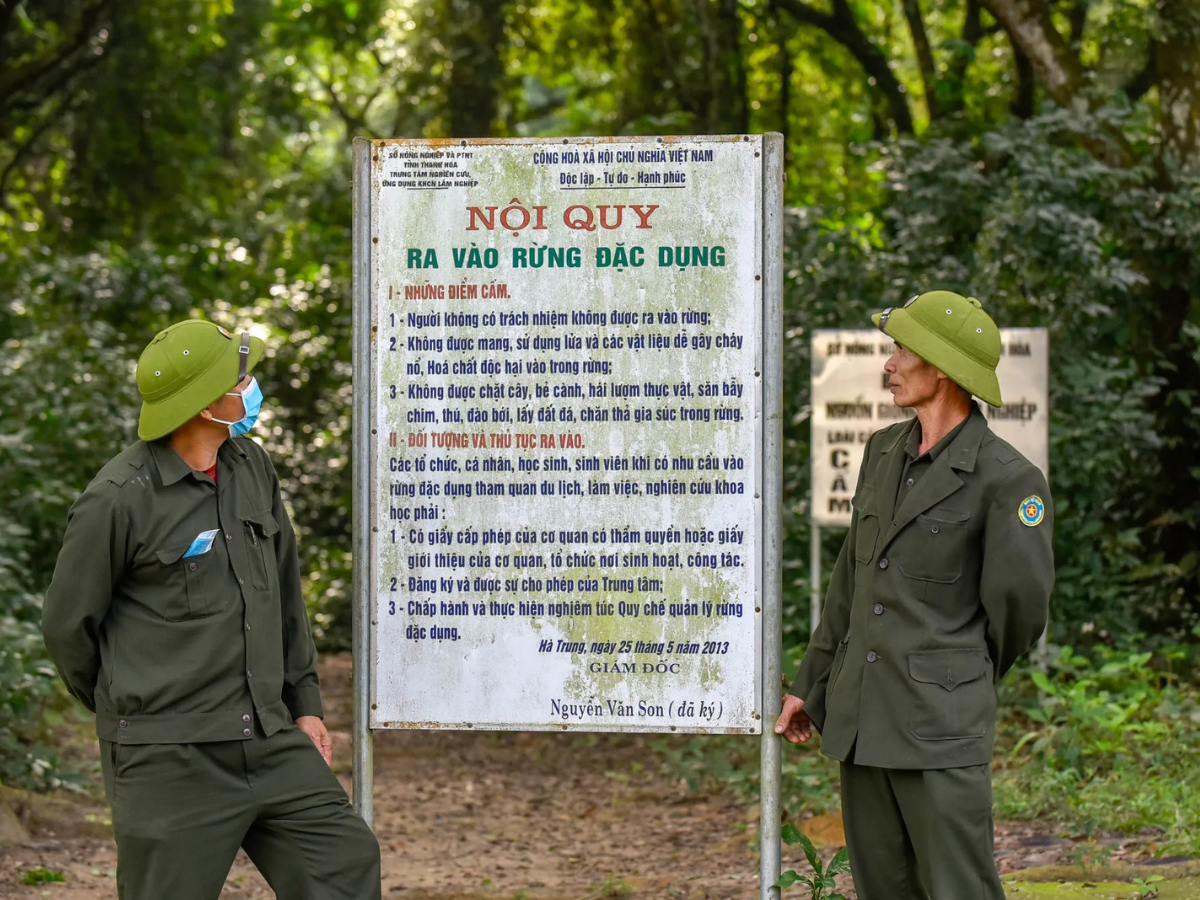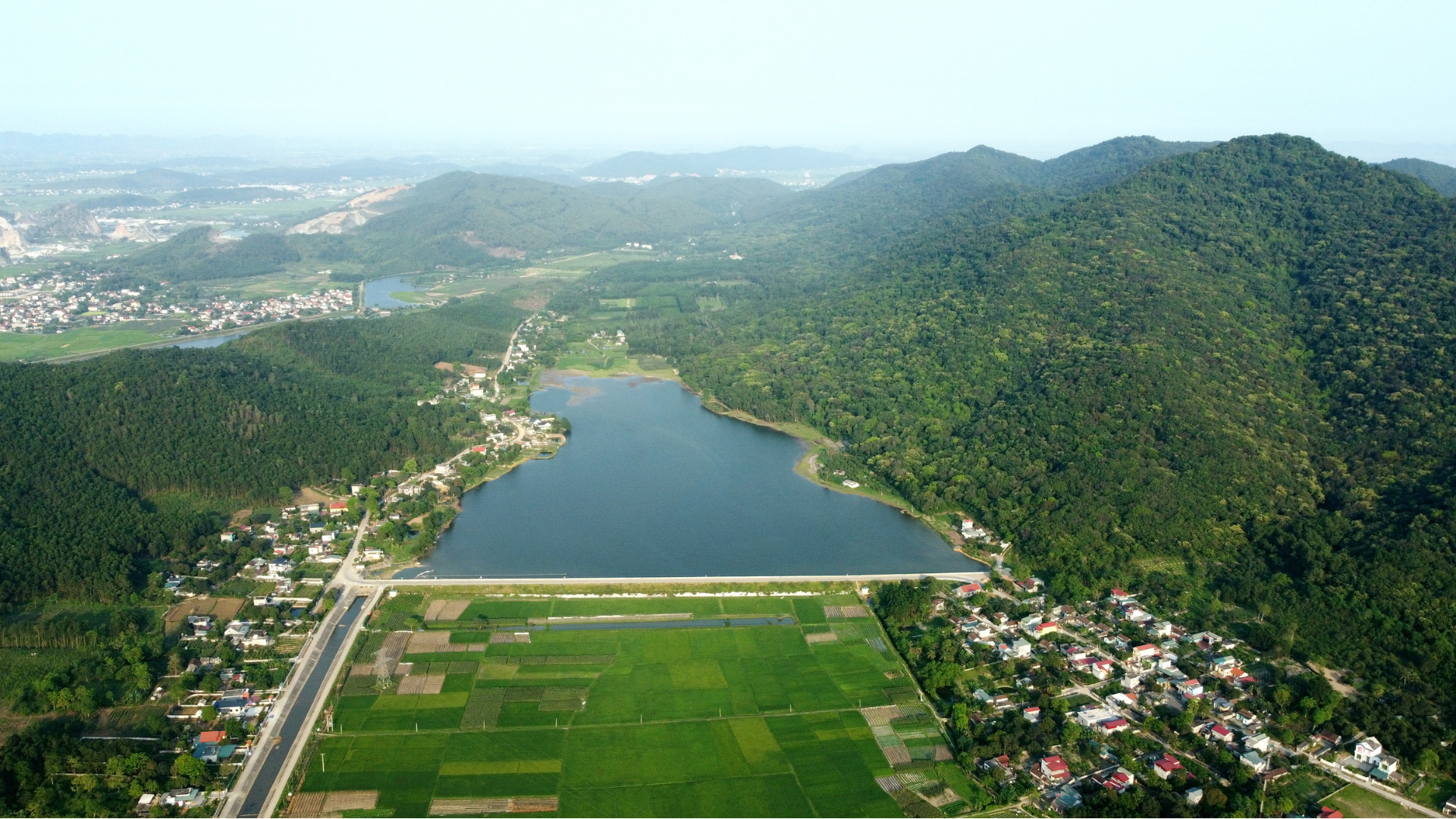1. Overview of Tam Quy Thanh Hoa Nature Reserve
1.1. Location, outstanding features
Located in Ha Trung commune, Thanh Hoa province, Tam Quy Nature Reserve is about 25 km from Thanh Hoa city.
With a total area of about 520 ha, the reserve is divided into two zones: the core primary forest zone and the protective buffer zone. The most outstanding feature that makes this place unique is the pure forest of Sen Mat trees, a rare phenomenon in nature. Ancient Sen trees, over 100 years old, with trunk diameters up to 70 cm, create a majestic landscape.
1.2. History of formation and scale of Tam Quy Thanh Hoa Nature Reserve
According to Decision No. 194/CT issued on August 9, 1986, by the Chairman of the Council of Ministers, Tam Quy Nature Reserve was established with the primary goal of protecting the precious Sen Mat forest ecosystem. Initially, the reserve's area was only 350 ha, but thanks to strict protection efforts and effective natural seed dispersal, the current area has reached 520 ha.
The diverse distribution of fauna and flora here contributes to creating an almost complete ecosystem. Besides the dominant Sen species, the forest also hosts many precious wood types such as Lim, De, Thong Nhua, and So. The animal system in the reserve is also very rich, with the presence of many species that are endangered in their natural habitat and have been almost untouched.
2. Ecological characteristics and conservation value of Tam Quy Thanh Hoa Nature Reserve
2.1. The only pure Sen forest in Tam Quy.
The highlight of Tam Quy is the 520 ha Sen Mat forest, recognized as the largest in Southeast Asia. Unlike mixed forests, this area primarily consists of a single tree species, forming a uniform green canopy.
Ancient Sen trees, hundreds of years old, stand majestically like witnesses of time. The trunk diameter of each tree can reach up to 70 cm, demonstrating resilience and sustainable development across generations. Each Sen tree is not only part of the forest but also a valuable gene source for scientific research.
2.2. Diversity of rare flora and fauna
Besides the endemic Sen species, Tam Quy Thanh Hoa Nature Reserve also has many precious wood species such as Lim, De, Thong Nhua, and So. Each species contributes to maintaining the sustainable structure of the forest canopy and holds significant economic value.

The lush, dense, and vibrant beauty at Tam Quy nature reserve. (Source: Law Newspaper of Ho Chi Minh City Electronic)
The value of the nature reserve extends beyond local boundaries. It serves as a source of precious plant and animal genetic resources for the North Central region, supporting long-term research and conservation. The biodiversity here also plays a crucial role in regulating local climate and preserving groundwater for surrounding life and production.
3. Scientific, Economic, and Cultural Values of Tam Quy Nature Reserve in Thanh Hoa
3.1. Significance for Research and Biodiversity Conservation
For researchers, Tam Quy is an ideal place to find rare and unique specimens. The characteristic of the pure Sen forest is a valuable source of information for research topics on ecology, plant genetics, and various conservation solutions.

Sen honey is mainly distributed in China, Vietnam, and some Southeast Asian countries. (Source: Compilation)
Notably, the profession of beekeeping for honey from Sen flowers has become a characteristic job for the local people here. Beehives cared for among the canopy of Sen trees produce honey with a unique flavor, preserving the essence of the old forest. This work not only helps preserve the environment but also allows people to maintain their livelihoods through harmony with nature.
3.2. Forestry and traditional medicine economic value
The wood of Sen, Lim, and De species has been valued by local people since ancient times. Sen wood is highly durable, suitable for traditional house construction, crafting agricultural tools, and is also a good material for making charcoal for metal forging. The sturdiness of this type of wood has been proven through hundreds of years of history.

Sen wood is often used in construction, and the trunk of the sen tree has a high calorific value used for forging furniture and agricultural tools. (Source: Collected)
Sen fruit when ripe has a naturally mild sweetness, often picked by locals and used as a source of supplementary food. Oil pressed from sen seeds is rumored to help support cardiovascular function, while sen leaves play a role in folk remedies to support inflammation treatment and wound healing. Tam Quy Thanh Hoa Conservation Area, like a green lung, brings clean air to the local community, while also contributing to local economic development towards sustainability.
4. Directions and Itinerary for a 1-day visit to Tam Quy Thanh Hoa Conservation Area
4.1. How to get to the conservation area from major cities
The journey from Hanoi to Tam Quy is quite convenient, covering about 170 km along National Highway 1A to the South. You can choose to travel by private car or bus, with an average travel time of 2 to 3 hours.
By private car: The round-trip fuel cost ranges from 350,000 to 450,000 VND. You need to drive to Ha Trung commune, then turn into the branch road and travel about 5 km further to reach the conservation area.
By bus or limousine: The one-way ticket price is usually between 150,000 and 300,000 VND per person.

Transportation to Tam Quy Thanh Hoa nature reserve is diverse. (Source: Collected)
The fastest way for visitors from Ho Chi Minh City to Tam Quy is to fly directly to Tho Xuan Airport (Thanh Hoa). The flight will take about 1 hour and 45 minutes, with ticket prices ranging from 1,500,000 to 3,000,000 VND depending on when you book.
From Tho Xuan Airport, you can continue your journey by taxi or ride-hailing service. This route takes an additional 1.5 to 2 hours of travel. The estimated cost for a car rental from the airport to the nature reserve is from 800,000 to 1,200,000 VND.
4.2. Accommodation and dining suggestions for visitors exploring Tam Quy
In Ha Trung commune, you can easily find various types of accommodation to suit different needs. Nearby hotels are priced from 300,000 to 500,000 VND per room per night, offering an experience close to the locals, a chance to enjoy authentic home-cooked meals, and listen to stories of life intertwined with the ironwood forest. If you prefer more comfort, hotels in Thanh Hoa city center are also a reasonable choice, with full services and prices ranging from 600,000 to 1,200,000 VND/room/night.
When you come to Ha Trung, your nature exploration journey will be more complete by enjoying the incredibly rich culinary landscape here. This area boasts a diverse system of restaurants, from places with luxurious and cozy spaces to specialized eateries for hot pot, grilled dishes, and fresh seafood, ready to satisfy every palate.
Hoa Thang, Thien Chau, or Co Do restaurants not only impress with their exquisite architecture (from modern to classic) but also serve a diverse menu, harmoniously blending rustic, high-end dishes, and specialties from the three regions.
For those with a passion for the flavors of the sea and countryside:
- Loc Tinh seafood restaurant stands out with fresh seafood and unique countryside specialties such as rabbit salad and frog stew.
Opening hours: 09:00 - 22:00
Address: National Highway 1A, Ha Trung commune, Thanh Hoa province
- Those who love traditional cuisine cannot miss Thien Chau Restaurant – a place notable for its classic, cozy ambiance and a rich menu featuring flavors from the three regions. The dishes are delicately prepared, beautifully presented, and guaranteed to be "delicious – nutritious – safe," making it an ideal culinary destination for family, friends, and gatherings.
Opening hours: 07:00 - 21:00
Address: Hoat Giang commune, Thanh Hoa province
- Countryside cuisine with the criteria of delicious, clean, and unique at Thuan An restaurant
Opening hours: Open all day
Address: South of the Military Gas Station, Hoat Giang commune, Thanh Hoa province
4.3. Combine entertainment and shopping within Thanh Hoa's tourism ecosystem
After experiencing the Tam Quy Thanh Hoa nature reserve, you can combine it with a visit to Sun World Sam Son, about 45 km from Tam Quy, to enjoy entertainment activities, participate in novel games, or relax by the beach. Sam Son beach with its fine white sand, and Tam Diep pagoda with its spiritual significance, are all stops that can be added to your itinerary.

Sun World Sam Son gathers a series of top-notch games and experiences. (Source: Collected)
Additionally, don't forget to bring back local specialties such as sesen flower honey, exquisite handicrafts made from sesen wood, or forest teas with the distinct flavor of Thanh Hoa region as souvenirs after your trip.
5. Useful experiences and tips when visiting Tam Quy Thanh Hoa Nature Reserve
To have a complete trip at Tam Quy Nature Reserve, you need to prepare carefully regarding attire and understand safety rules.
Bring specialized trekking shoes for easy movement on the trails. Attire should be long-sleeved (long, loose) clothing to protect against insects and skin from thorny plants. Don't forget a wide-brimmed hat, a light jacket, along with items like mosquito repellent and a power bank. Always bring enough drinking water and light snacks.
When exploring the sesen forest, always follow the marked trails and do not leave the group. To preserve the natural environment, maintain silence, do not disturb the ecosystem, and keep a safe distance from wildlife.

Tam Quy Forest has specific regulations for visitors. (Source: Compilation)
To capture wonderful moments at the Sen forest, take advantage of the hours from 6 AM to 8 AM or wait until around 4 PM to 6 PM. The light at this time will be soft, highlighting the poetic beauty of the forest. Additionally, don't hesitate to experiment with creative shooting angles, such as shooting from the base of the tree looking up, to honor the grandeur of the ancient trees.
Moreover, take time to connect friendly with the local people, especially beekeepers. Chatting and asking for permission before taking photos not only shows respect but also helps you learn more about the traditions and experience of protecting this precious forest, making your exploration journey more meaningful and memorable.
Tam Quy Thanh Hoa Conservation Area is a must-visit destination in 2025. Not only is it an opportunity to admire the largest Sen forest in Southeast Asia with its wild and majestic beauty, but it's also a place to experience unique eco-tourism. Furthermore, a journey to Tam Quy will help you directly discover sustainable scientific and cultural values and contribute to the conservation of this precious natural heritage.








